

Text, Coupons Replace Flash Deals as Mobile Holiday Focus. With mobile shopping more popular than ever, it’s no surprise retailers are planning to focus more on mobile this holiday season.
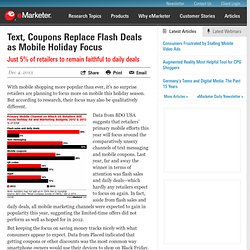
But according to research, their focus may also be qualitatively different. Data from BDO USA suggests that retailers’ primary mobile efforts this year will focus around the comparatively unsexy channels of text messaging and mobile coupons. Last year, far and away the winner in terms of attention was flash sales and daily deals—which hardly any retailers expect to focus on again. In fact, aside from flash sales and daily deals, all mobile marketing channels were expected to gain in popularity this year, suggesting the limited-time offers did not perform as well as hoped for in 2012.
But keeping the focus on saving money tracks nicely with what consumers appear to expect. UK Web Users Flock to Digital Banking Is the Future of Programmatic Premium?
Global Markets. How E-Commerce Changed Our Lives Forever. Get Business Newsletters: The most successful e-commerce websites are designed to define clients' needs and expectations, then exceed them by delivering an impeccable online experience.
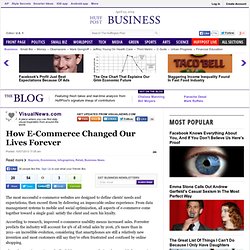
From data management systems to mobile and social optimization, all aspects of e-commerce come together toward a single goal: satisfy the client and earn his loyalty. According to research, improved e-commerce usability means increased sales. Forrester predicts the industry will account for 9% of all retail sales by 2016, 2% more than in 2011--an incredible evolution, considering that smartphones are still a relatively new invention and most customers still say they're often frustrated and confused by online shopping. Along the way, innovative and affordable e-commerce solutions have enabled companies like Amazon, Staples and Apple to translate their ideas into successful online businesses. Entrepreneurs begin e-commerce business via Facebook - Vote for the best company in Dallas's business competition. Amy Coffee and Amy Claro use Facebook as their medium for e-commerce.
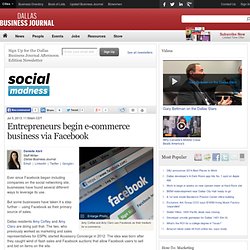
Ever since Facebook began including companies on the social networking site, businesses have found several different ways to leverage its use. But some businesses have taken it a step further -- using Facebook as their primary source of sales. Dallas residents Amy Coffey and Amy Claro are doing just that. The two, who previously worked as marketing and sales representatives for ESPN, started Accessory Concierge in 2012.
The idea was born after they caught wind of flash sales and Facebook auctions that allow Facebook users to sell and bid on items on the site. This is how it works: A vendor will post an item along with a price on their page. It's the use of social media to further a company's business that is at the heart of Social Madness, a contest designed to measure a business' engagement with its audience through Facebook, Twitter, LinkedIn and Google Plus. How is ecommerce likely to evolve? Five key trends. The Five New Rules of eCommerce. Linda Taddonio, Chief eCommerce Strategy Officer & Co-Founder, Insite Software, looks at how you can re-engineer your business for successful B2B sales in the digital era.
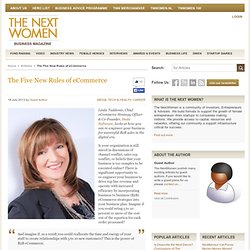
Is your organization is still mired in discussions of channel conflict, sales rep conflict, or beliefs that your business is too complex to be executed online? There is significant opportunity to re-engineer your business to drive top line revenue and operate with increased efficiency by incorporating business to business (B2B) eCommerce strategies into your business plan. Imagine if you could wring 5 to 10 percent or more of the cost out of the equation for each order processed? And imagine if, as a result you could reallocate the time and energy of your staff to create relationships with 5 to 10 new customers? This is the power of B2B eCommerce. While many still associate eCommerce as a business to consumer tactic, its adoption is growing rapidly in the B2B world. Rule No. 1: Map out the journey.
E-Commerce Sales - E-commerce returns to pre-recession growth. U.S. e-commerce sales totaled $64.8 billion in the second quarter, up 18.5% from $54.7 billion in the second quarter of 2012, according to an estimate released today by the U.S.
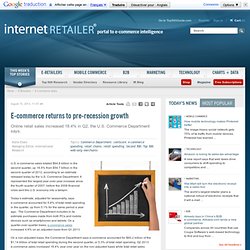
Commerce Department. It represented the largest year-over-year increase since the fourth quarter of 2007, before the 2008 financial crisis sent the U.S. economy into a tailspin. Today’s estimate, adjusted for seasonality, says e-commerce accounted for 5.8% of total retail spending in the quarter, up from 5.1% for the same period a year ago. The Commerce Department includes in its estimate purchases made from both PCs and mobile devices such as smartphones and tablets. Ecommerce: how are startups adapting to its emerging market success?
As ecommerce picks up, certain interesting trends start to form that shows how startups are adapting to their individual markets.

This is most prominent in specific emerging markets where the current impressive growth rates leave much room for developments in the future. Almost each country or region has its own set of advantages and disadvantages. Here are some I thought were worth noting. Some interesting market trends Other than experimenting with different payment methods, on the other side of the coin there’s getting access to the target market.